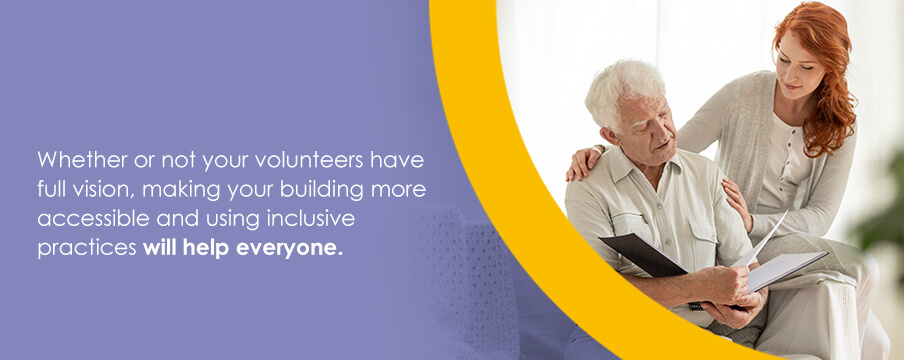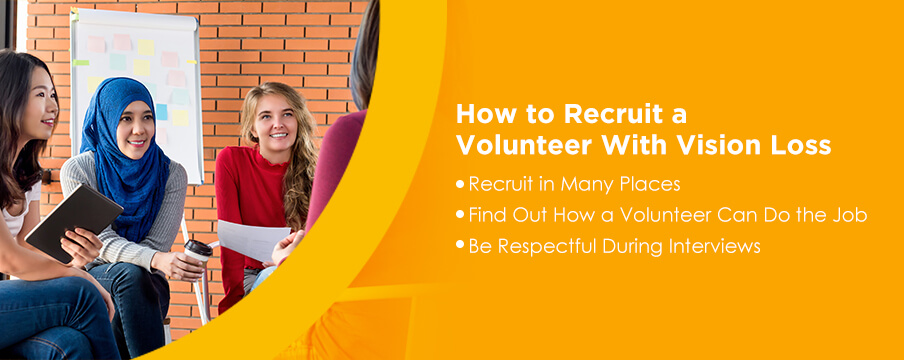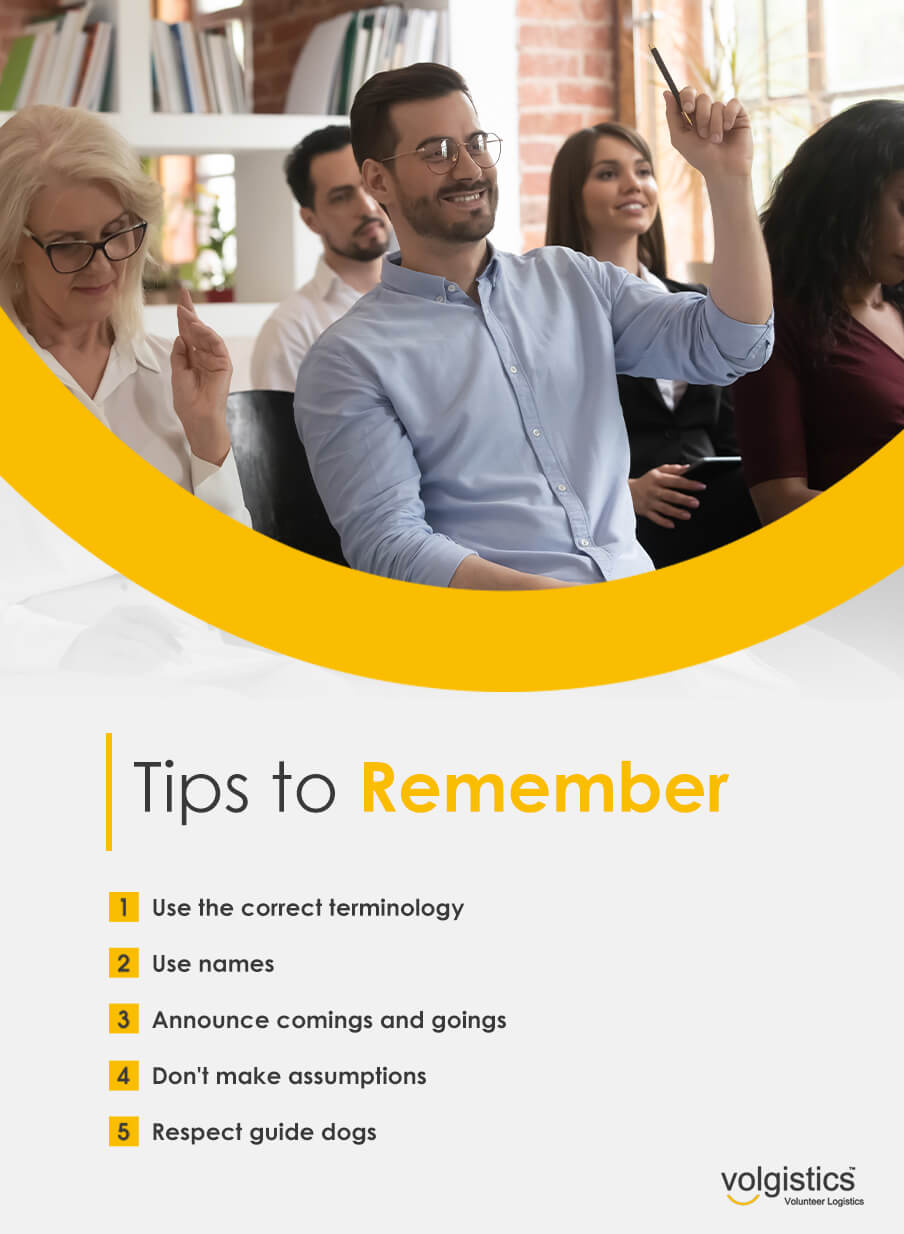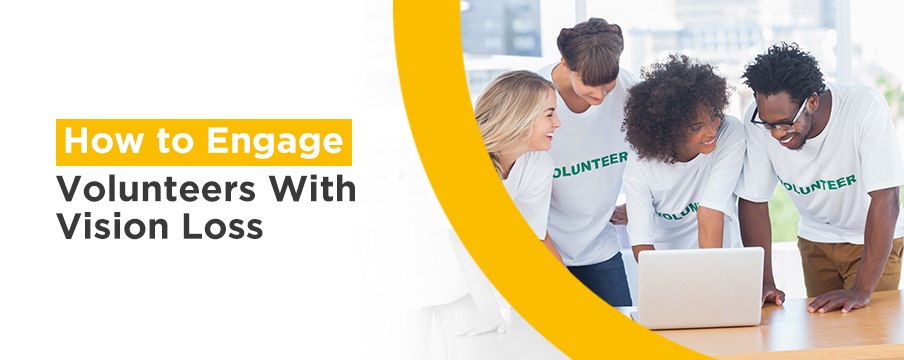Some nonprofits are surprised to learn there’s a vast community of volunteers with vision loss. Many volunteer at organizations aimed at helping others with sight loss. Others love to get involved with other causes they care about. Like any other volunteers, people with limited vision can make a huge difference in their communities and the world.
To tap into this group of passionate volunteers, you might need to make a few accommodations. Once you know how to work with visually impaired people, you can gain new perspectives and help others unlock their full potential.
As an intuitive and user-friendly volunteer management software, Volgistics can help. The software lets you easily track and store data on your volunteers. Leave notes in each volunteer’s file so anyone who works with your volunteers will know what accommodations to provide. Follow this guide for more tips to engage with people who have vision loss at your volunteer organization.

How to Prepare for a Volunteer With Vision Loss
Your organization may have more volunteers with vision loss than you might think. If you work with older adults, they may have some degree of age-related macular degeneration. As many as 11 million adults in the United States and 30% of those over 75 have age-related macular degeneration. Others with low vision may not be obvious unless they’ve told you or use a guide dog or white cane.
Remember, not all vision impaired people are completely A person with vision loss will have some form of sight unless they are blind. They may see blurry or fuzzy objects or have lost only their central or peripheral vision. You may not even know a volunteer is experiencing sight loss because they are well adapted. A volunteer with limited vision can be a massive boon to your organization. While they may not be able to drive, they can fill many other roles and responsibilities in your nonprofit. With a few easy-to-make accommodations, they can contribute meaningfully and make a difference in the world.
It can be challenging to know how to prepare for volunteers with visual impairments. Whether or not your volunteers have full vision, making your building more accessible and using inclusive practices will help everyone. You’ll establish your environment as an inclusive space and open yourself up to blind and partially sighted volunteers. A person with vision impairment who wants to volunteer will look for an organization that can support them. By preparing beforehand, you can attract more volunteers of all abilities.
Here are a few preparations your organization can make for volunteers with vision loss:
1. Make Your Volunteer Policy Inclusive
Your volunteer policy is one of the first things volunteers read when they consider working with your organization. Make sure it’s written with inclusive language and specifically mention accessibility for people with disabilities. Express your willingness to accommodate the individual needs of anyone who wants to give their time.
Then, put your policy into action. Educate your team and other volunteers about sight loss and how to work alongside colleagues with disabilities. Make sure your staff and volunteers use correct vision loss etiquette.
2. Create Accessible Documents
Many documents help volunteers learn their roles and follow expectations. You may need to provide these digital and physical documents in an accessible format for those who have sight loss. While Volgistics can store many different types of documents, we recommend uploading word documents, .XLS, or .TXT files rather than PDFs or scanned documents to the VicDocs portal. These formats are more compatible with text-to-speech software.
If you provide hard copies of volunteer documents, use a clear, large-print, and legible font. You can also use quality Braille translation software and an embosser to create Braille versions of your documents. Note that some people with sight loss do not read Braille, while others require it. Some people may prefer audio recordings. If you have documents that include graphics and pictures, include alternative text that describes it.
3. Keep Your Office Hazard Free
If your building complies with the Americans with Disabilities Act, you already have some accommodations to help those with vision loss navigate your office. For example, your room signage will have high-contrast and tactile text. You also wouldn’t have any ceiling- or wall-mounted structures that reach below standing height, which someone could hit their head on if they didn’t see.
It’s up to you to make sure your workspace stays safe for all who use it. Removing tripping hazards benefits everyone. Don’t keep boxes, ladders, or other items in hallways or other footpaths, and secure all furniture properly.

How to Recruit a Volunteer With Vision Loss
People with sight loss want to contribute in a meaningful way, just like any other volunteer. Only about 44% of people with vision loss in the U.S. are employed, while the rest are either unemployed or not in the labor force. People who are blind or have low vision have time to give. For some, volunteering can also be a crucial stepping stone to gain career skills.
Recruiting partially sighted volunteers can also benefit your organization. It opens your volunteer pool to a new group of people. If your cause involves people with disabilities, having people with vision loss on your team can be another way to help and connect with your community. Regardless of your mission, you can show the public how committed you are to inclusion and accessibility.
There are many ways to work with volunteers with vision loss. People with low vision can take part in almost any volunteer position. They can perform administrative work, serve on boards or committees, advocate with lawmakers, increase public awareness, and directly serve your organization’s cause in the community.
As with any volunteer, a person with sight loss has many interests and skills. One of the best ways to engage volunteers with vision loss is to give them a role based on those interests. Don’t relegate them to busy work. Instead, let them challenge themselves and achieve things they can be proud of. Find out what they can and want to do, and try to match each role to the volunteer’s needs and expectations.
1. Recruit in Many Places
To attract volunteers with diverse abilities, include the right language on your recruitment materials. Something as simple as saying you welcome and can accommodate applicants with sight loss and diverse abilities can be effective. Make sure your website and volunteer application are accessible and use unadorned, large-print fonts on digital and physical materials.
When it comes to vision loss, your volunteer engagement can look pretty similar to any other type of volunteer engagement. Backed with inclusive language in your advertisements and collateral, use all the recruitment methods you can to attract a diverse range of volunteer applicants. Advertise at volunteer centers and websites, social media, radio, and newspapers. You can also reach out to the sight loss community by partnering with nonprofits with a related mission. A nonprofit dedicated to the cause can act as an essential resource to help you engage volunteers with vision loss, too.
2. Find Out How a Volunteer Can Do the Job
When a person with vision loss applies to a volunteer position, you may wonder how they will perform in the role. Chances are, the applicant has learned how to handle many of the same tasks a sighted person can. They just do them a little differently.
For example, some blind people can identify various bill denominations by touch. They can transfer this skill to a role in handling money, such as selling your nonprofit’s merchandise or taking cash donations. Knowing what to expect from volunteers with vision loss depends on the individual. Don’t make any assumptions.
It’s natural to worry about what questions to ask a person with vision loss during recruitment. If you focus more on what the person can do rather than the sight loss itself, the interview will go much smoother. Keep in mind that people who are blind or have low vision can do almost anything with suitable accommodations. Focus on how the volunteer will handle a task, not if they can.
To do this, describe the duties involved in the role, and ask the interviewee how they would complete them. You can also feel free to ask what accessibility tools they use for computer work and other tasks. Some use magnifiers, text-to-speech readers, or refreshable Braille devices. Volunteers often already have the equipment they need and can bring it with them when they report for a volunteer shift.
An interview is also an excellent time to ask how to accommodate the needs of volunteers with vision loss if you’re unsure. Everyone has unique needs, so it’s good to have a one-on-one conversation with any volunteer who needs special accommodations.
3. Be Respectful During Interviews
It helps to remember a few basic rules for how to interact with a person who is blind or has low vision. Some common principles include:
- Don’t censor yourself: Everyday phrases like “see you soon” and “take a look at this” are perfectly acceptable language. People with vision loss use these terms, too.
- Give verbal directions: When giving directions to the interview site, be specific. Don’t use vague terms like “over there.” Instead, be clear and direct, and use landmarks like “the first door on your left.” Frame things in terms of the listener’s left and right rather than your own. When the applicant arrives, feel free to describe the environment to help them orient themselves. For example, say something like, “We’re going to sit at this rectangular conference table. Your chair is to your right, and I’m going to sit across from you.”
- Identify yourself by name: During your first meeting and thereafter, announce yourself when you enter a room. Avoid assuming someone will recognize your voice.
- When in doubt, ask: It’s best to ask before reading documents aloud. Some people may need you to read it, while others do not. If you’re not sure what assistance the person needs, ask how you can help them. Avoid being overbearing or overprotective. A conversation about how to make things easier for volunteers with vision loss can go a long way.
How to Support a Volunteer With Vision Loss
To ensure long-term success in your volunteer placements, you must provide ongoing support. People with sight loss may need some different kinds of assistance. Here’s how to support volunteers with vision loss:
1. Use the Sighted Guide Technique
People with vision loss can usually navigate on their own in familiar environments. When a volunteer first starts working for your organization, it may help to use the sighted guide technique until they can gain that familiarity. In crowded environments, a sighted guide may also come in handy. After learning the technique, talk to the volunteer about the settings and circumstances requiring a sighted guide. Here are a few steps to take when acting as a sighted guide:
- Let the person with vision loss grasp your arm above the elbow, with their thumb facing out.
- Walk a half step in front of the person you’re guiding.
- In narrow hallways or doorways, move the back of your hand to rest against your lower back. The person being guided will slide their hand down to your wrist and walk directly behind you at an arm’s length.
- Approach stairs, curbs, and doors squarely, never at an angle.
- At a doorway, tell the person which way the door swings so they can hold the door as you both pass through.
- Let the person know when you are approaching stairs, whether they go up or down, and how many. Ensure the person’s free hand is closest to the rail, and pause at the first step at each landing.
- Inform the person when you are approaching a seat and when they are in front of or beside it. Place the person’s hand on the chair’s arm or back, and let them seat themselves.
2. Help Them Learn and Become Comfortable in Their Environment
The sighted guide technique can be an essential first step in helping new volunteers orient themselves at your office or volunteer sites. It also helps to describe the physical environment and layout. Describe where the bathrooms, stairs, elevators, and evacuation routes are. Point out any potential obstacles, like an overhanging cabinet. Let the volunteer know before you relocate furniture or other objects at the office. Ask if you can do anything else to help the volunteer get comfortable in the workspace.
3. Have Veteran Volunteers Mentor New Volunteers With Sight Loss
A new volunteer will need lots of training to get started in their new role. Many volunteer organizations use a mentorship program, which can be especially helpful for a volunteer with sight loss. Choose an established volunteer who understands the role and can explain it well. This mentor will give the new volunteer someone to direct questions to and a friendly face to help them get acquainted with the team. This can help ease a lot of the stress that comes with navigating a new environment.
4. Prepare Specific Verbal Instructions
As you’re training your volunteer in their new role, adjust your training techniques to rely on verbal and spoken instruction. If your training usually involves a presentation, you may need to translate pictures and graphs into spoken language. If using a slideshow in a group, pause to describe each slide. Whenever a new person speaks, they should start by stating their name. When the training session adjourns, make it clear that the meeting is over, and say “goodbye” when leaving a person with vision loss.

Tips to Remember
When your organization works with a volunteer with vision loss, you and your team can make a few minor changes in behavior to help them feel comfortable and prepared to succeed. Here are some tips for working with people who are blind or partially sighted:
- Use the correct terminology: While it’s safe to use colloquialisms like “see” and “look,” some words and phrases may not be as acceptable. For example, some people do not like the terms “visually impaired” or “visual impairment,” and others are OK with it. You can always ask what words the person prefers.
- Use names: Don’t assume someone recognizes you by your voice alone. Make it a habit in your office to use your name when you begin talking. For example, say, “Hi, it’s Susan.” When speaking to someone, address them by name, too. Talk to the person directly, not through a companion if they have one.
- Announce comings and goings: It can be frustrating to talk to someone who isn’t there or not to know who’s in the room with you. When you enter a room, make your presence known. Let a person with vision loss know when you have to step out. Say “goodbye” before you leave for the day.
- Don’t make assumptions: Every person with vision loss is different. Even two people with the same condition may experience it differently. Ask everyone what kind of assistance and accommodations they need, and avoid offering unwanted help. Help out when needed without being overbearing. Aim to be polite and respectful, and treat every person with sight loss as individuals with their own interests, personality, strengths, and weaknesses.
- Respect guide dogs: If the person has a guide dog, remember that it’s on duty whenever it’s wearing a harness. Don’t pet, talk to, or otherwise interact with the dog while it’s working.

Prepare Every Volunteer for Success With Volgistics
Partnering with volunteers who have vision loss can be as rewarding for them as it is for your organization. Most accommodations are simple changes that make the workplace more accessible to all. With a few preparations and the proper support, your volunteers with diverse abilities can thrive and contribute to a cause they believe in.
If you want to learn more about how Volgistics can make managing all your volunteers a little easier, start exploring today. We’re happy to set up a live demonstration, and you can start testing the software in a free pre-loaded account any time you like.

